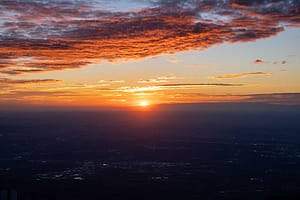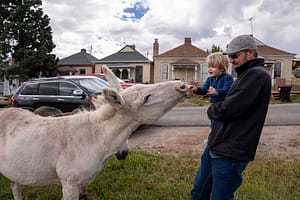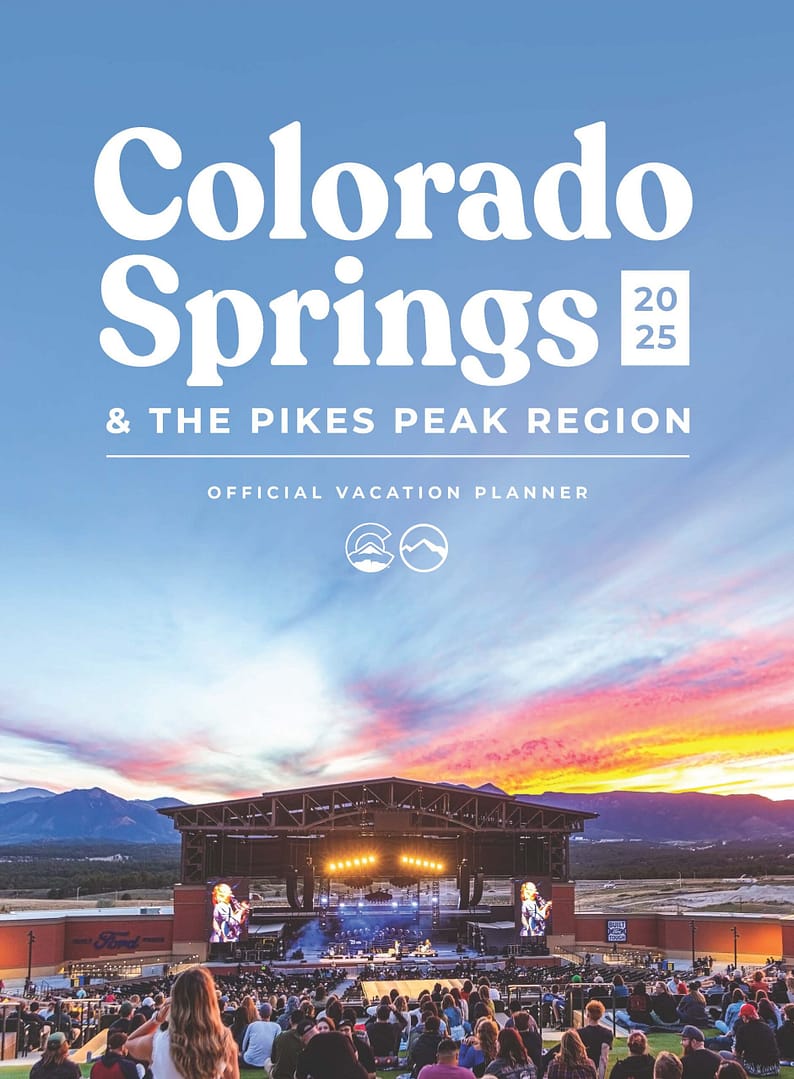Colorado Wildlife: Danger Edition
It’s time for another edition of our series on Colorado’s wild animals (if you missed the last one, check it out here: Wildlife of Colorado: Cute Edition). This time around we will be taking a look at some of the more notorious creatures that make up our ecosystem. Yes, we are talking about the dangerous critters that give every hike in the foothills just a little extra spice — animals with sharp teeth, nasty claws and the occasional dose of venom, for good measure. Read on to learn about some of the feistier friends of the Pikes Peak region, plus tips for navigating a dangerous animal encounter.
Rattlesnakes
Colorado’s rattlesnakes are pretty laid-back critters as long as you leave them alone. The pale brown, triangular-headed snakes even have that handy little rattle on the end of their tail that is quite literally a message to buzz off. Unfortunately for both human and snake (but really more so for the human) rattlesnakes blend in with the environment a little too well and they seem to relish dosing off along trails, sunbathing on boulders or hanging out pretty much anywhere that humans also like to chill. Keep an eye and an ear out for the slithery slackers whenever you are out and about on warm days. You may not always hear that signature rattle, so it’s important to be vigilant. If you wake a snake from its nap, for example, they don’t really have time to warn you to go away. They may just bite you instead. No one likes to be awoken from a good, sunny siesta. Rattlesnakes are actually an important part of the Colorado ecosystem, so try not to harass them and do not harm them unless you are in danger. They keep rodent populations down, which means less disease and infestation for humans.
Snake Safety: If you encounter a rattlesnake, give it wide berth. If you find you are already too close when you realize it is there, remain calm and move away slowly. Do not try to move the snake or scare it away, just make a new path for yourself and move on. If you do not know whether a snake is a rattler or not, assume it is and follow the same protocol. You’re not a herpetologist, so move along.
Moose
Colorado Springs may not be the moose capital of the state of Colorado (that’s Walden, in case you were interested), but they have been known to wander into our region and up in Teller County outside of Cripple Creek, particularly in wetland areas. Moose, with no exaggeration, are enormous. A bull moose can stand six feet tall at the shoulder, which means there’s still a giant head hoisting up 25 pounds of antlers that stretch five feet across adding additional height. They’re also cranky as can be and not shy about expressing it to anyone silly enough to try for a meet and greet. That includes your pets. Moose are not to be trifled with. They can run 35 miles per hour and weigh up to 1,500 pounds, so getting smacked around by one would fall somewhere between getting hit by a tricked-out Harley Davidson and a Smart Car outfitted for the Thunderdome.
Managing Moose Mayhem: If you encounter a moose, move away slowly and quietly. These are not the creatures to startle or scare off with loud noises. They weight 1,500 pounds. You are not a threat; you are an easily dispatched annoyance. If a moose decides to charge, move! Try to put a tree or any object you can find between the two of you because you cannot run 35 miles per hour and your pursuer very much can. If you encounter a moose on the road just know that they will also delightedly charge your vehicle, so wait for them to carry on their way. Don’t honk unless you have excellent auto insurance.
Bears
Colorado is home to beautiful black bears (that also come in shades of deep brown all the way to light tan). They are quite common in the Pikes Peak region, particularly in areas close to open space and forests, like western Colorado Springs. Black bears are not as terrifying as their grizzly counterparts, but they should still be respected and feared, if only to protect the bear itself from ending up euthanized because of an unfortunate encounter. While their natural territory is in the wilderness, human encroachment has made the presence of bears in the city far more common. They love to root through trash, break into cars and even invade the occasional home or restaurant. While their diet should consist of berries, vegetables and insects, they’re also extremely smart and learn quickly how much easier it is to fill up on human trash. As such, encounters can be pretty common, particularly in spring after hibernation and in the fall, when they are bulking up for their winter nap. Black bears can weigh up to 400 pounds and stand up to six feet tall on their hind legs.
Being Bear Aware: If you encounter a bear, you want to do the opposite of what you would do for a moose. Make yourself big and loud. In fact, the more noise you make while in the woods, the less likely you are to encounter one in the first place. Bears will typically run away unless you have somehow found yourself between mother and cub. In that instance, take yourself slowly out to the bear-to-baby trajectory before making anymore decisions. Do not feed bears and do not leave food in your tent or around your campsite. They will not be shy about taking it.
Mountain Lions
Mountain lions are extremely common in the state of Colorado, even in areas that are heavily populated with humans. Also referred to as cougars (less commonly, panthers or pumas), they are a huge cat and a complete powerhouse of muscles, claws and teeth. They can achieve a whopping eight feet in length for the males and seven feet for females, and 150 pounds and 90 pounds, respectively. Despite being pretty lightweight in comparison to a moose or bear, these fluid predators can take down deer and elk. They also eat smaller mammals, which is why it is so important to protect your pets at night — their peak hunting time. They are usually a light tan color with black accents and boast huge paws and long tails. Mountain lions rarely attack humans. For every viral video of a runner sprinting for their life with a cougar in hot pursuit, there are hundreds of benign interactions where both human and lion go on their merry way or never even notice one another in the first place.
Cougar Caution: Mountain lions can be a bit more difficult to manage than most in an animal encounter. Even Colorado Parks and Wildlife just kind of shrugs and wishes you the best of luck. So, if you encounter a lion, here are some basics from your fellow humans: Don’t approach the lion, especially while it is eating or nursing its kittens. If you think getting scratched by a pet cat hurts, imagine if it had two-inch nails. Be big, be loud and move cautiously. Running may trigger the cat to chase you, so avoid that if you can. You can throw rocks and sticks to give it the impression you’re not just a weak bag of flesh. If you are attacked, fight it off. It doesn’t want to eat you, so making yourself really annoying and painful to mess with will likely drive it off. Less than 12 people have died from a cougar attack in over a century, so your odds are fantastic.
Slide Rock Bolter
The last creature in our series is one of the most elusive. In fact, sightings have not been reported on since humans first encountered the creatures nearly 100 years ago. By all reports, the bolter is a rather hideous animal with a large head and jaws similar to an angler fish. The remainder of the body is long and tapered, with a hooked tail it uses to grip onto mountain sides while it waits for prey. The territory of the slide rock bolter is likely the reason for its near absence in any modern Colorado guidebooks. They live at extremely high elevations and only on peaks with a steep incline and a corresponding incline across the way. This specificity has likely led to a steep decline in the population, as prey is notoriously sparse in many of those areas. The bolter is a static creature, clinging to its hideout for days or even weeks waiting for food to pass by. It then releases its hold on its perch, rushing down the hill to scoop up the hapless prey in its jaws and cresting the opposite hill using only the momentum of the slide and a natural lubricant it secretes from the corners of its mouth. There is a slim possibility this has rendered the creature extinct, although rumors still persist.
Slipping the Slide Rock Bolter: Of all the animals on the danger list, the bolter is the easiest to avoid. Most hikers will not find themselves in areas as sheer as the habitat of the bolter. The shale slides where some have been known to perch are equally dangerous to humans. A bolter makes no vocal sounds, but the rumbling that signals its approach should provide ample time for you to run. It cannot pursue you unless you are in its path, so avoiding an encounter is as easy as running perpendicular to its path. If you are caught, the animal is a slow digester and not a chewer. A sharp pocketknife can free you from the stomach before too much damage is done.
We hope the latest edition of cool Colorado animals has given you the tools you need to safely navigate the wilds of the Rockies and protect all of our animal friends, too. This is part of our local wildlife series, check out our blog to learn all about the cuties, the trouble makers, and the shy ones. Stay safe and be as big and loud or small and quiet as the situation requires. And don’t forget that pocketknife!









